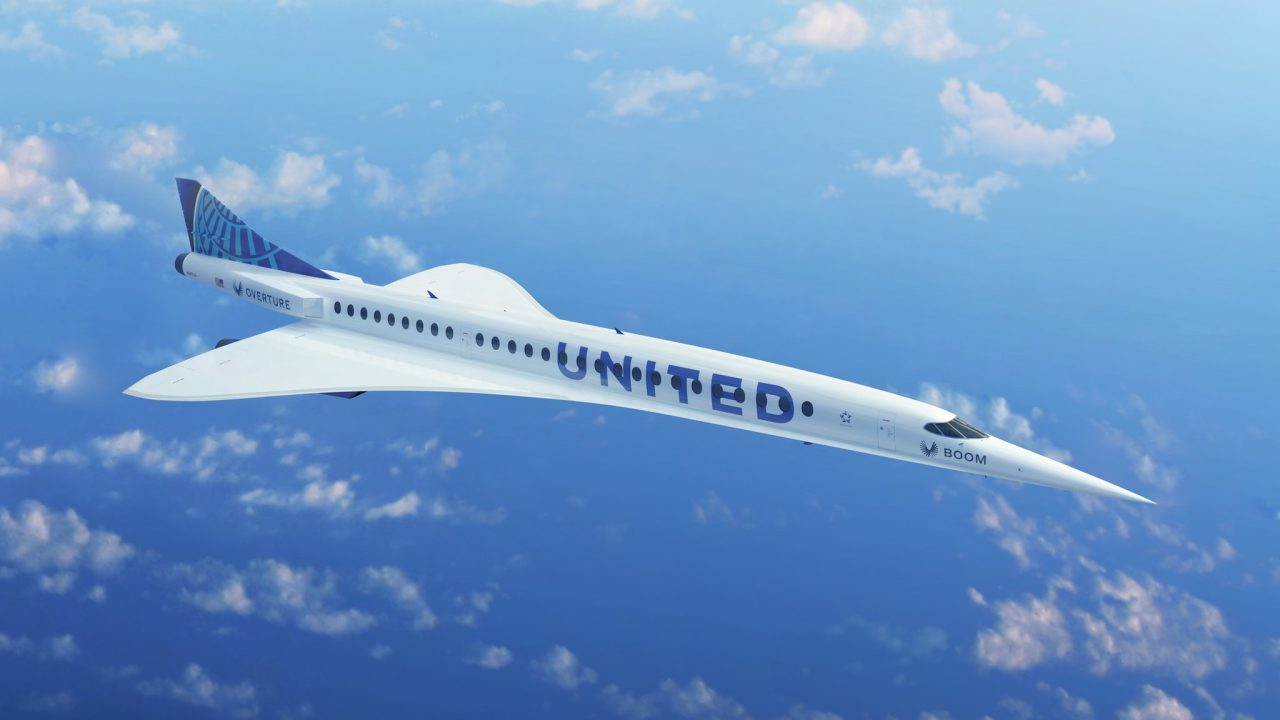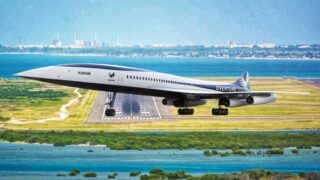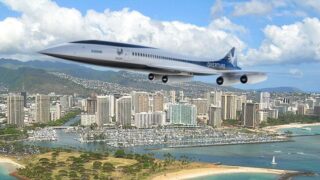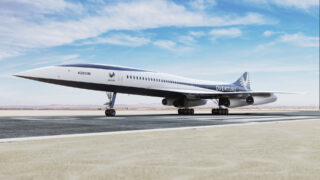The next frontier in Hawaii air travel is said to be only six years away, and we plan to watch it play out with you. Not since jets revolutionized travel in the 1960’s, have we seen anything like the proposed Boom Supersonic Overture aircraft in terms of flights to Hawaii. The coming change has some distinct similarities with the last revolution in jet travel. And yet, it is entirely different, with new technology, and appealing to different Hawaii visitors.
It seems the timing could not be better. United Airlines CEO Scott Kirby has underscored the need for greater diversity and competition within the aerospace sector against the longstanding duopoly of Boeing and Airbus. That comes amidst their safety, production delay, and quality control challenges.


This sentiment opens a window of opportunity for other companies, with Boom Supersonic potentially being one of them. Boom, of course, is hoping to pioneer the next generation of air travel by developing the Overture supersonic jet.
Boom’s entry into the market has the potent to disrupt the traditional aerospace landscape by offering a radically different product focused on speed and efficiency. This would align with Kirby’s vision for more diversified aircraft options and invigorate competition in an industry dominated by just the two major players.
How younger generation Hawaii travelers are driving the future.
Boom believes that these could be the biggest drivers and beneficiaries of supersonic travel. Known for their desire for quick, efficient, and sustainable travel, this next generation might find Hawaii more appealing as a travel destination that matches their values and style. Social media, which significantly influences younger people’s travel decisions, could further enhance Hawaii’s appeal, depicting it as an accessible paradise perfect for spontaneous adventures.
Emerging travel habits of younger Hawaii visitors may also suggest they will be the most enthusiastic about the time-saving and planet-friendly possibilities allegedly offered by this new supersonic technology, which would bring them to Hawaii 50% faster than ever before.
Supersonic flights may still redefine Hawaii travel.
Imagine jetting off to our lush tropical landscapes in half the time it currently takes. With naysayers abounding, Boom Supersonic’s groundbreaking Overture aircraft may still see this become a reality. The re-emergence of supersonic travel, according to Boom at least, is poised to transform global travel patterns as dramatically as, and in many of the same ways that, the Jet Age did.
Sixty years ago, jet air travel entirely reshaped Hawaii from an exclusive luxury destination into a travel hub bustling with tourists from all corners of the world. Could this be about to occur once again?
Hawaii and the Jet Age, a historical context.
Six decades ago, the debut of the Jet Age in Hawaii marked a pivotal chapter in the islands’ story, making them accessible to mainstream travelers for the first time. When air travel prices plummeted from a cost of $5,500 to a mere $99, Hawaii’s allure suddenly skyrocketed, creating a dramatic transformation led by aviation advancements and a still insatiable urge to travel.
Personal tales, like those of BOH editors Jeff and Rob, underscore the profound impact of this era; their first flights to Hawaii not only introduced them to the islands but also connected them deeply with its community and culture.
Hawaii supersonic travel’s potential may mark another groundbreaking chapter.
Today, Boom Supersonic is trying to steer us towards the potential of a new frontier with its Overture SST aircraft. It’s designed to fly at twice the speed of current jets. And it’s good enough that it has amassed a huge book of orders and investors ready to help move it to fruition.
Recent updates at Boom, including successful tests and approval for supersonic flight tests, hint at a near future where Hawaii could be a supersonic flight away from major cities worldwide. This advancement could open Hawaii to further global connectivity, making shorter island escapes feasible even for distant travelers. Not only that, but the prospect of reaching Hawaii from the west coast in under three hours, also holds great appeal.
Sustainability considerations of Boom Supersonic.
Boom’s commitment to using 100% sustainable aviation fuels and to reducing noise pollution are steps in the right direction that, of course, remain to be proven. They are particularly crucial for preserving Hawaii’s delicate natural environment and ensuring that the growth in tourism does not undermine the very attractions that draw people to the islands.
Standing on the possible brink of a new era in Hawaii travel.
It’s thrilling to consider the possibilities supersonic travel opens up, not just for global tourism but for Hawaii in particular. The islands could soon see a revival in their role as a premier global destination, accessible from anywhere in half the time.
We invite you to share your thoughts and memories of Hawaiian travel. How do you see supersonic travel influencing your future visits to the islands?
Get Breaking Hawaii Travel News






If these aircraft are allowed to cross the USA at supersonic speeds, they might have a shot. But prices will be the final determinant.
Those prices will be very high and could easily destroy funds for hotels, restaurants and shopping.
Both Hawaii and the airlines need to resolve their dysfunctional relationships with Tourists/Passengers, before I would be willing to pay the upcharge to arrive quicker. Rather than visiting twice a year we would stay longer or visit every other year. Im ok with a longer flight as long as the airline ( lookin at you AA) can make it an enjoyable experience. But still a lot of love/ hate to work through.
Just what we need, more rich people flying to Hawaii more often. Why???
There are not enough resources to support this. Please slow down take a breath, and think about the future of these beautiful islands, not the future of money, but people.
Tom,
The folks are struggling, and you want less tourist income for them?
And why just rich people in your post?
I wouldn’t want to take the chance. Hawaii’s government might mistake it for a incoming missile or ICBM and shoot it down before it lands. Also what if a pilot takes off with too much thrust and creates a sonic boom close to the airport. Broken windows to replace and lots of people with broken ear drums. Same problem flying over US cities.
Slower is always safer than faster. Airlines have enough stress crack issues and rivot problems as it is now. Just remember planes don’t have brakes in the air other than flaps and throttle.
We love Hawaii and we have been coming to Hawaii for 4 decades.
Travelling day is always challenging given the 6 hour main route flight and the connecting flights before and after the main flight makes travelling day a real challenge and a long difficult day.
If the main flight is only 3 hours, it makes our travel much more pleasant less onerous. We would be looking forward to the flight day rather than dreading it.
As an airplane nerd….I would love to see a SST as an option to visit family in the Chicago area. That would make 8 hour to ORD and 9 hour from ORD flights 4-4.5 hours. But again, as an airplane nerd, if they do not mitigate the boom associated with supersonic travel, the only places getting SST travel will be coastal cities (SFO, LAX, SEA, etc…). Not sure supersonic travel from DFW, ORD, JFK, and other inland cities will be worth the extra cost.
Just my thoughts. Feel free to shoot me down.
I think it is great. However, the costs incurred in six years to visit Hawaii will even worse than they are now. Regular air travel will be much higher, let alone hotels, short term rentals(if allowed), car rentals, food and incidentals, putting SST travel out of reach for only those who truly can afford it, at least for the first 20 years. As a senior, on a somewhat limited budget, I will never be able to take advantage of this wonderful technology. I also think BOOM should also make a concerted effort to attract seniors. We are the original generation of planet earth protectors. Our physical health also benefits on shorter flights.
If reaching Hawaii in half the time and at twice the cost of current aircraft conditions, be ready to see often-shorter stays with more affluent guests flying on supersonic jets. That may please some high-end hotels and transient accommodation owners, but perhaps not. Many of the wealthy will be coming to Hawaii for a 2 or 3 day weekend trip, instead of a typical 7+ night stay.
Will supersonic jets be able to land only in Honolulu or can neighbor island airports accommodate such jets?
Can Beat Of Hawaii estimate what percentage of airline seats will be on supersonic jets as opposed to traditional jets a year from now? 3 years from now? 5 or 10 years from now?
Hi Bruce.
We’ll keep your questions in mind as this plan moves forward. We’d suggest that Maui and Honolulu are the likely airports.
Aloha.
Not a chance. There will be no $99 fares. $4000 or $5000 will probably be the starting point. Most folks (at least from the West Coast) can live with a 5-6 hour flight if it saves them $2000.
Speaking for myself, I could afford the higher price, but would never spend that much.
The way I see it, airlines (possibly new airlines) will offer longer flights for half the price and grab the lion’s share of customers. Will there be enough folks to pay so much more? Not from the West Coast, and that’s the majority of visitors to Hawaii.
Could the airlines get enough passengers from further distances to make it work – I don’t think so. To keep costs under control, many planes would have to be built.
Rod
With supersonic speed how in the heck do you have time to enjoy the fabulous tasting bologna sandwich and the upscale meal for the wife. I don’t think there would be anytime to enjoy that wonderful music she loves also. Ya know the old saying ” You can’t teach an old dog new tricks” IMO I hate change and according to my wife she say’s I’m stubborn as a Mule. I would rather get there safe and definitely not sorry. Don’t need a bad situation happen in a half of a blink of an eye verses a whole blink. I’m not in that much of a hurry to release my greenbacks. The longer funds are in my account means the more interest I make. Hey take care.
Sounds great but, just like the SST, will be very expensive. Having said that, I would try it once to experience it but could not afford it every time. Plus, you’re going to Hawaii, not to a business meeting in London. Reminds me of the line from the song “Kokomo:”
“Ooo I wanna take you down to Kokomo
We’ll get there fast
And then we’ll take it slow”
I suspect the fares to Hawaii using supersonic planes will be astronomical and only the 99% would be able to afford it. It will be interesting to see how economical these new aircraft will function. Fuel consumption was a definite game changer for the SST. The accident in France closed that chapter.
I’m so used to the flying time of 6+ hours, I can deal with that. I just wish these airlines would add a bit of comfort for the humans. Nah, won’t happen, capitalism always wins.